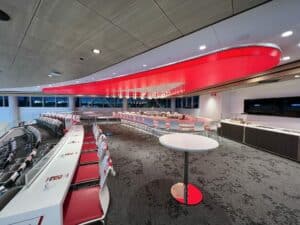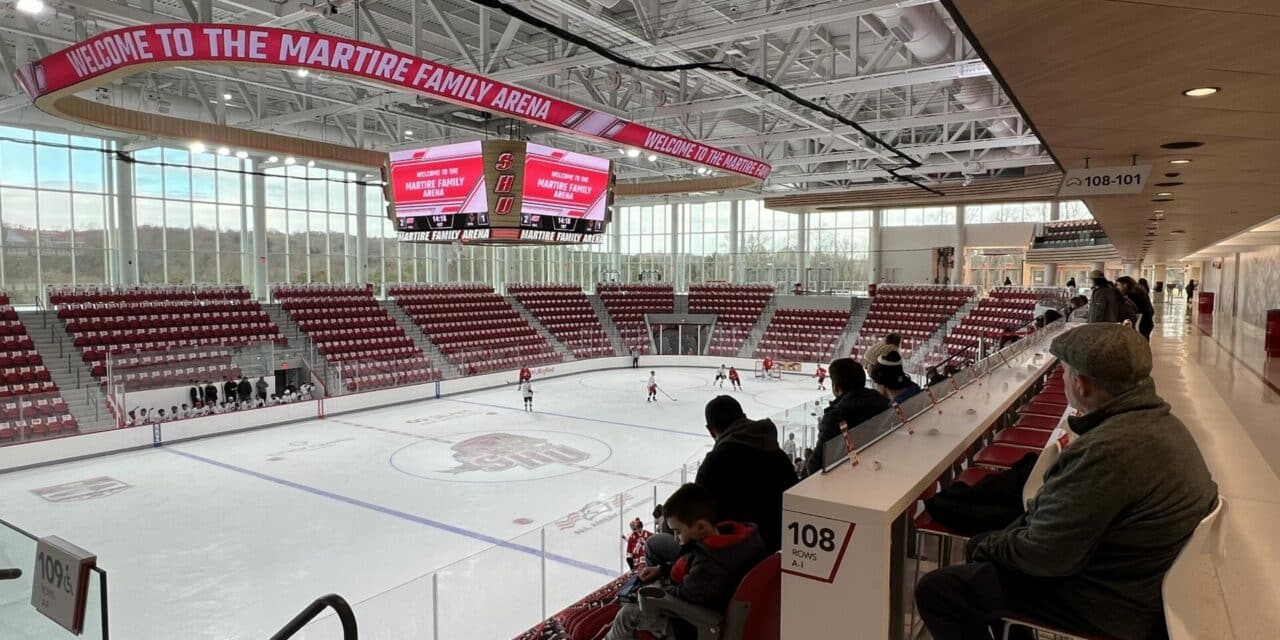SACRED TECH: Martire Family Arena, shown here during an alumni event, showcases “smart glass” technology that can control the amount of daylight coming into the building. (Courtesy Mike Wekesser)
Sacred Heart University unveiled its sparkling new hockey arena in mid-January as the private school pushes its NCAA Division I programs to a higher level to compete with elite teams across the country.
Martire Family Arena, a $70 million project, was designed by JLG Architects in conjunction with SLAM Collaborative, Dimensional Innovations and Consigli Construction, the general contractor.
The arena takes up a portion of the old General Electric headquarters, which now serves as the west campus of the Fairfield, Connecticut institution. The 4,000-capacity arena sits about a half-mile from the main campus.
The venue is home to Sacred Heart’s men’s and women’s hockey teams that are part of the Atlantic Hockey Association and New England Women’s Hockey Alliance, respectively. The Pioneers’ men’s squad previously played home games at Total Mortgage Arena, a 10,000-seater in Bridgeport, Connecticut, about eight miles southeast of Fairfield. The women’s home ice was about 10 miles northeast of campus at Sports Center Connecticut in Shelton, Connecticut.
The new arena also has Sacred Heart club teams in men’s and women’s hockey, the nationally-ranked women’s figure skating club program and high school youth hockey teams are tenants.
In addition, there’s classroom and laboratory space for Sacred Heart students studying sports communication and media, sports management and hospitality.
The building is named for donors Frank and Marisa Martire, who provided a $5 million gift to support the project. Frank Martire, a 1969 Sacred Heart graduate, is chairman of the university’s board of trustees and an investor in the NHL Vegas Golden Knights.
The arena site was originally proposed for a new natatorium before school officials switched it for hockey, according to Mike Wekesser, JLG Architects’ sports practice studio leader with 30 years of experience, dating to the old HOK Sport, Gensler and AECOM. Wekesser said the switch was driven by the school’s need to elevate its hockey programs and attract the best recruits possible.
Martire Family Arena is adjacent to a pair of older GE buildings and connects to an existing parking garage with 760 spaces that was part of the original complex. For hockey games and other events, students can take shuttle buses for the short ride to the arena, Wekesser said.

RED LINE: Martire Family Arena’s two club lounges provide views to the ice floor. (Courtesy Mike Wekesser)
The stylish venue stands out for its high-end finishes: the concourse terrazzo floor in white, red and gray, the school colors, wood decking on the suite/pressbox level and floor to ceiling glass walls tied to a 360-degree open concourse.
The exterior facade is wrapped with glazing material that glows at night and serves as a beacon to the west campus. It’s designed with “smart glass” technology that, with a flip of a switch, can change from clear views into the arena to a white, snow-like opaque appearance, providing privacy for the college teams, Wekesser said.
The technology is something relatively new for sports venues, he said.
“It’s going back to the original roots of hockey on pond ice,” Wekesser said. “We’re trying to take hockey, an introverted sport, into more of an extroverted feeling, the concept of taking that experience indoors.”
The arena’s videoboard system, produced by Daktronics, features a twist on LED displays with a rectangular-shaped halo ribbon board surrounding the center-hung structure. The ribbon board, designed to match the configuration of the ice floor, projects game stats, among other game day features.
There are three suites equipped with eight fixed seats and four drink rail spaces, plus the presidential suite with 30 fixed seats and 15 drink rails. Two club lounges in the end zones, named for Sam Adams beer and Consigli Construction, both support 68 cushioned seats and 20 drink rails.
Martire Family Arena falls in line with other Division I hockey programs building new facilities, which is JLG’s specialty, Wekesser said. Lonnie Laffen, an architect, former North Dakota politician and a lifelong hockey fan, founded JLG in 1989 in Grand Forks, North Dakota. Laffen died in 2020. JLG’s sports practice, which launched about 10 years ago, is in Minneapolis, Minnesota. All told, the company has about 160 full-time employees.
Ralph Engelstad Arena, the University of North Dakota’s 22-year-old hockey facility and considered among the finest in college hockey, was among JLG’s first college hockey projects.
Since that time, the architect has designed more than a half-dozen facilities at the college level, most recently, Colorado College’s Ed Robson Arena and Xtreme Arena, home to University of Iowa women’s volleyball and wrestling and the ECHL Iowa Heartlanders.
“Each one of these arenas has got a little bit bigger and better and more expensive and higher quality,” Wekessder said. “Hockey is our expertise. We’re looking at 10 to 12 projects on the boards. We’re doing a three-sheeter in Tucson now for the University of Arizona (club team).”
JLG competes against Perkins & Will, Populous and HOK to design college hockey arenas, as well as Crawford Architects, which won the job to plan a new $175 million basketball and hockey facility for the University of St. Thomas. JLG bid for the project after St. Thomas athletics two years ago made the jump from Division III to Division I.
“We’re expanding into other sports as well, trying to springboard off of hockey,” Wekesser said.







